Digestive distress comes in many forms — with causes as varied as eating a rich meal, public-speaking nerves, or PMS. If you’re feeling unsettled, movement can offer relief. Gentle yoga combined with breathwork may be a particularly powerful remedy.
“There are three main ways that yoga can support digestion and gut health: physically, mentally, and energetically,” explains Life Time studio lead Madden Zappa, CPT, RYT-200, and a certified yoga and breathwork instructor.
Physically, she says, yoga boosts blood flow and circulation to the digestive tract and organs. Plus, many postures help relieve pelvic, hip, and abdominal tightness, which can contribute to (and result from) digestion issues.
Mentally, yoga reduces stress levels and regulates the parasympathetic nervous system, which is responsible for our ability to rest and digest.
And energetically, yoga supports the chakras, or “wheels of energy that travel from the tailbone to the crown of the head,” Zappa explains. “Over time, these wheelhouses of energy can get stuck or clogged. Yoga can help keep these channels open.
“If you’re experiencing uncomfortable digestion, you’ll want to try and stay away from more vigorous forms of yoga and opt in to a more restorative practice,” such as yin. A belly-supporting flow could include gentle compression, stretching, rotation, and breathwork.
With this restorative mix in mind, Zappa offers the following series. Perform this flow on its own or combine it with a 15-minute walk whenever you need some digestive support.
The Poses
Easy Pose With Box Breathing ⋅ Cobra Pose ⋅ Prayer Twist ⋅ Seated Twist ⋅ Supported Seated Forward Fold ⋅ Wind-Relieving Pose ⋅ Supine Twist ⋅ Plow Pose
Sukhasana (Easy Seat) Meditation With Box Breath

Repeat for two to three minutes. (Over time, work up to a five-minute meditation.)
Full Instructions
- Come to a comfortable seat on a mat, with legs crossed; raise your hips on a block or bolster, if needed.
- Place your palms on your knees or your belly. You can close your eyes.
- Inhale through your nose for a count of four.
- Hold that breath for a count of four.
- Exhale through your nose for a count of four.
- Hold for a count of four.
- Practice taking deep, slow breaths using a technique called “belly breathing” — so-called because the belly, rather than the chest, moves in response to each breath. It can be helpful to imagine that your belly is a balloon, expanding with each inhale and deflating with each exhale.
- Repeat for two to three minutes. (Over time, work up to a five-minute meditation.)
Bhujangasana (Cobra Pose)
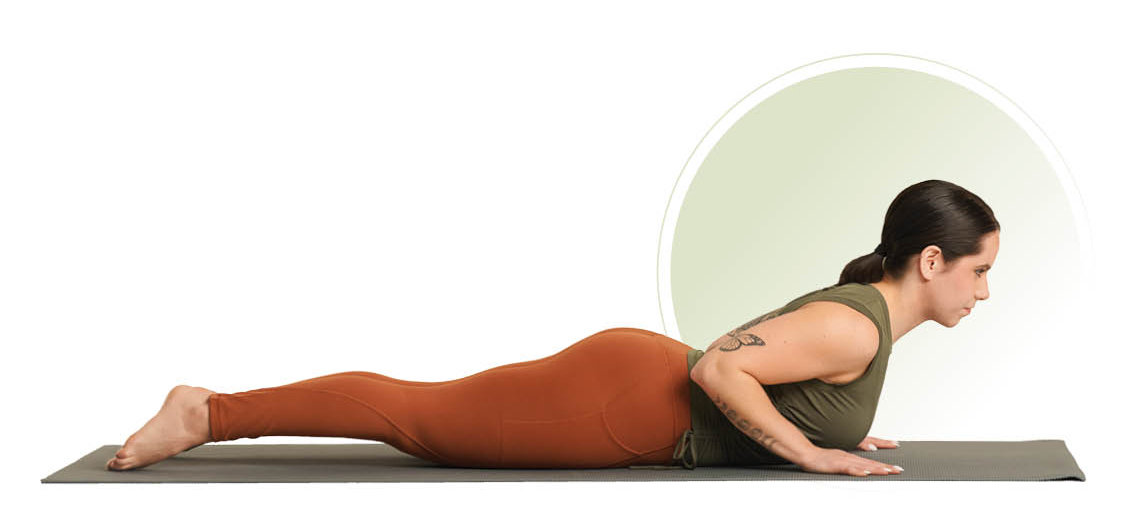
Hold for five to seven breaths, then lower your upper body slowly to the floor.
Full Instructions
- Lie face-down on your belly, with legs extended, feet hip width apart, and the tops of your feet firmly on the ground.
- Position your hands under your shoulders, elbows tucked close to your body.
- Engage your glutes and back muscles to lift your chest off the floor. Use your hands for support as you lift, but avoid pushing up to force a deeper range of motion. Keep at least a slight bend in the elbows and maintain contact between the front of your hips and the mat as you stretch the front of your body.
- Draw your shoulder blades down and back and breathe deeply as if trying to fill your lungs to the sides and back of your body.
- Hold for five to seven breaths, then lower your upper body slowly to the floor.
Parivrtta Utkatasana (Prayer Twist)
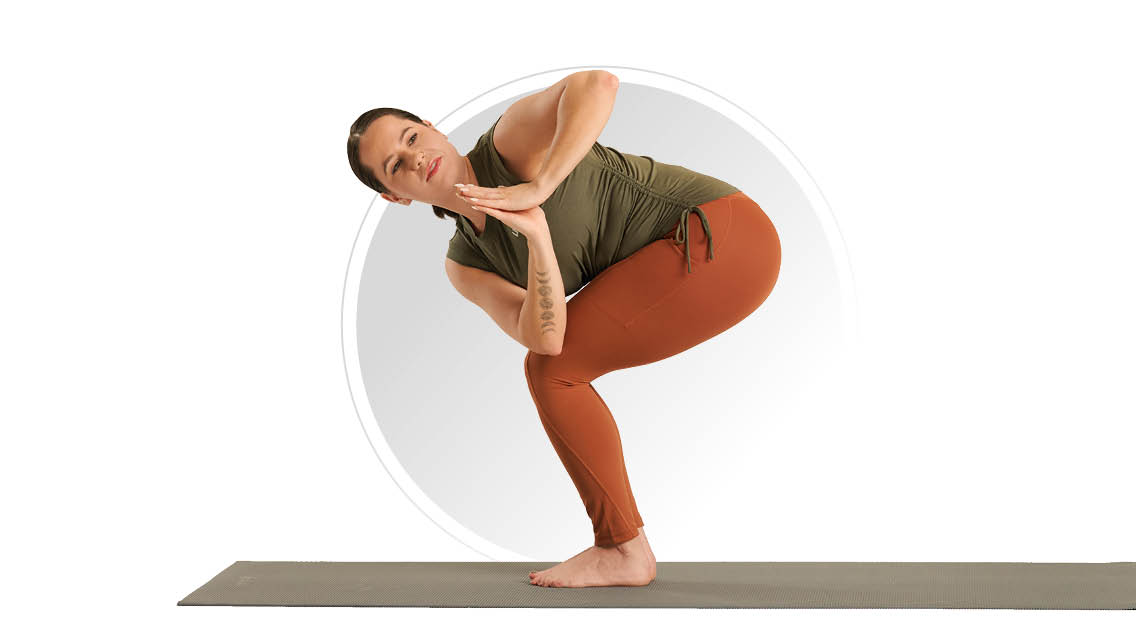
Hold for five to seven breaths.
Repeat on the opposite side.
Full Instructions
- Begin standing tall with your feet together (or hip width apart, depending on comfort).
- On an inhale, raise your arms overhead.
- On an exhale, bend your knees and lower your hips as if you were taking a seat in a chair. Simultaneously lower your arms and bring your palms together, thumbs at your chest.
- Inhale, then on your exhale twist your torso to the left, bringing your right elbow to the outside of your left thigh. Keep your hips square and knees aligned.
- Maintaining a neutral spine as you open your chest to the left, press your upper right arm against your thigh.
- Turn your gaze upward, if possible; if this bothers your neck, gaze at a spot on the floor.
- Breathe deeply, lengthening your spine as you inhale and twisting deeper as you exhale.
- Hold for five to seven breaths.
- On an inhale, release the twist and return your torso to center. Exhale to return to standing.
- Repeat on the opposite side.
Ardha Matsyendrasana (Seated Twist)
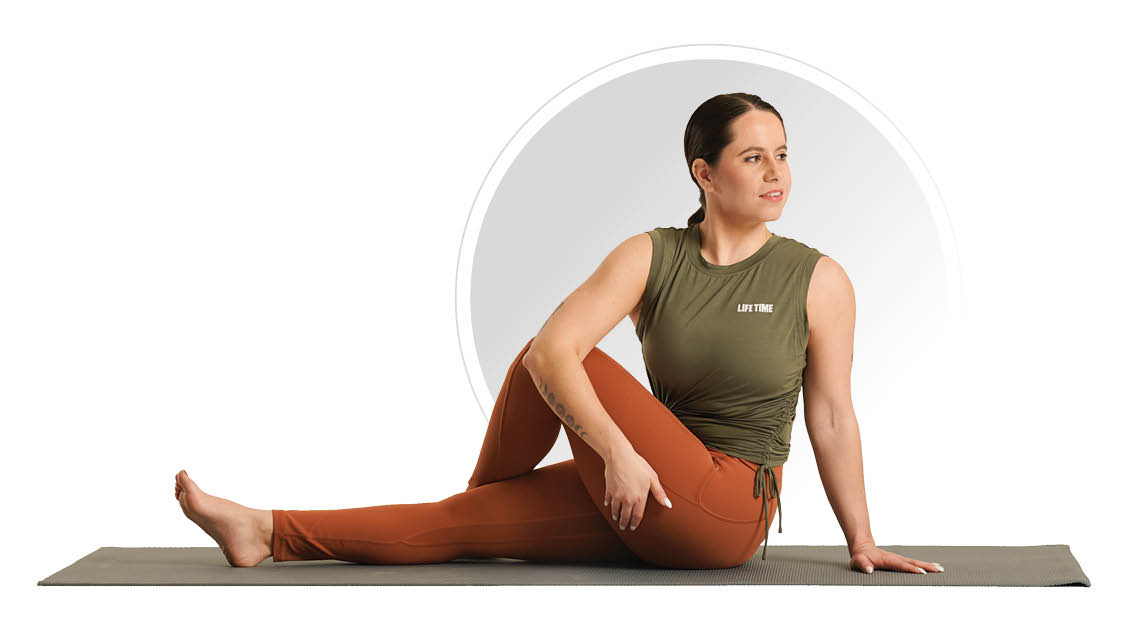
Hold for five to seven breaths, then slowly release the twist and return your torso to center.
Repeat on the opposite side.
Full Instructions
- Sit on the floor with both legs straight. Cross your left knee over your right leg and place your left foot on the floor.
- Adjust yourself to sit with your sitz bones firmly planted and your left knee pointed at the ceiling. Keep your right leg extended straight, or bend your right knee and tuck that foot by your left hip.
- Place your left hand beside your left hip or slightly behind you. Inhale and extend your right arm overhead.
- On an exhale, rotate to the left and draw your right elbow down to the outside of your left knee. If hooking the elbow is too difficult, reach your left hand around your left thigh and place it gently on your left hip. If it’s comfortable, you can turn your head to the left and gaze over your right shoulder. Avoid forcing your head or wrenching your neck to get deeper into the posture.
- Hold for five to seven breaths, then slowly release the twist and return your torso to center.
- Repeat on the opposite side.
(For more on the seated twist, plus two variations, see “How to Do the Seated Twist.”)
Supported Paschimottanasana (Supported Seated Forward Fold)
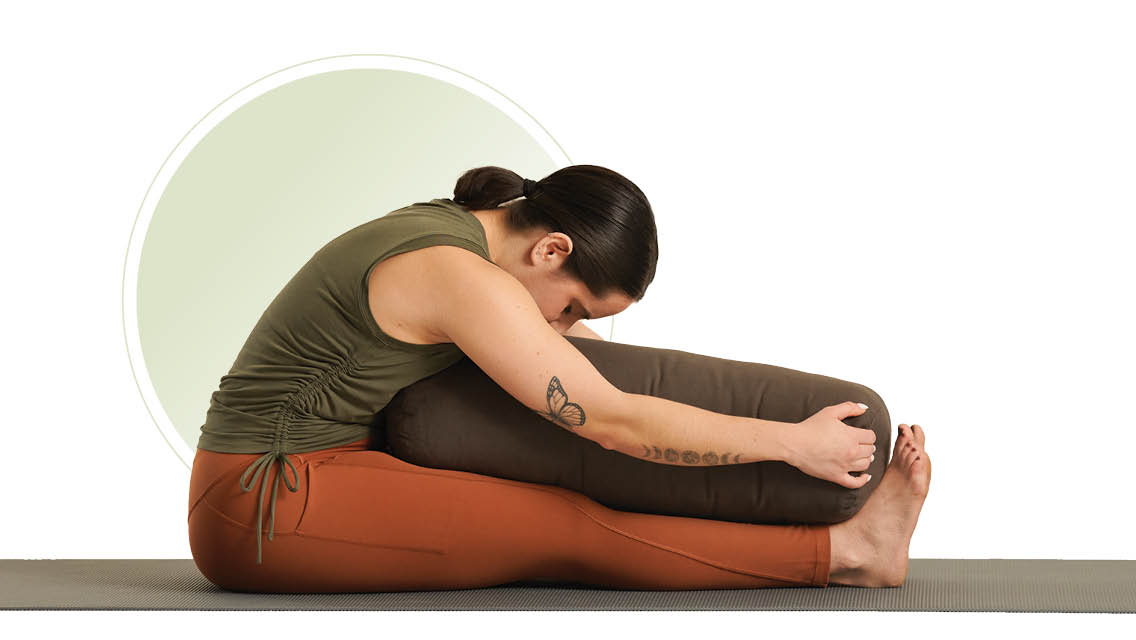
Hold for two to three minutes. (Over time, work up to holding for five minutes.)
Full Instructions
- Sit on the floor with both legs straight and heels flexed. Place a bolster (or rolled up towel or blanket) along the top of your legs. Optionally, raise your hips by sitting on a folded blanket.
- On an inhale, sit up tall. On an exhale, hinge at your hips to lean forward and come to rest your chest on the bolster.
- Layer blankets, towels, blocks, or other props to raise the support to an appropriate height that allows for a position that feels restful and limits how much your lower back has to round. Relax your hands at your side or on the bolster.
- Breathe deeply. On each exhalation, settle deeper into the forward fold.
- Hold for two to three minutes. (Over time, work up to holding for five minutes.)
- Inhale to return to a tall, seated position. As you do, lift your head slowly and rise up with a flat back.
Pawanmuktasana (Wind-Relieving Pose)
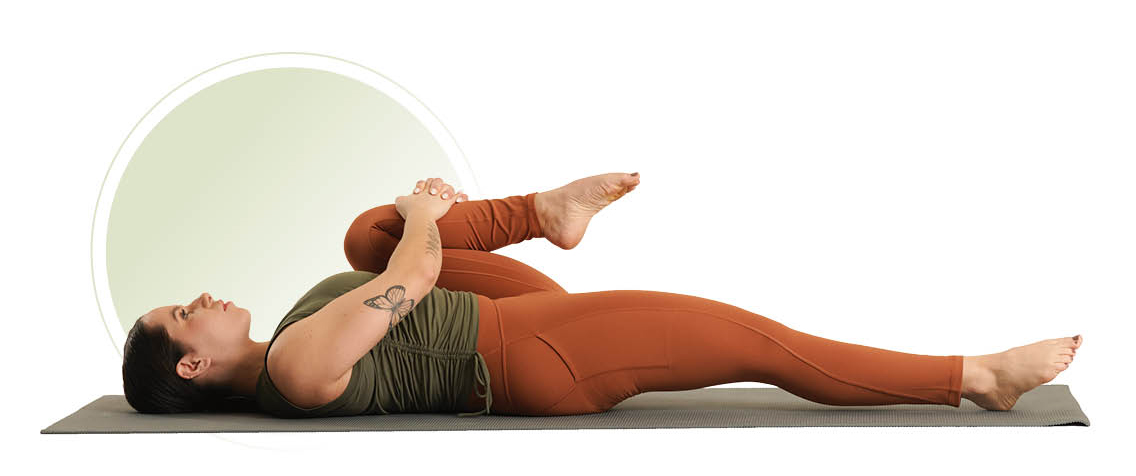
Hold for five to seven breaths.
Repeat on the opposite side.
Full Instructions
- Lie on your back with your knees bent and feet on the floor.
- Draw both knees into your chest. Wrap your hands or arms around your knees, giving yourself a little hug and rocking side to side if it feels good. Return to stillness.
- Grasp your right knee with both hands and extend your left leg on the floor.
- Hold for five to seven breaths.
- Draw your left knee back in toward your chest and hug both knees again.
- Repeat on the opposite side, this time drawing your left knee in and extending the right leg.
Supta Matsyendrasana (Supine Twist)

Hold for two to three minutes.
Repeat on the opposite side.
Full Instructions
- Lie on your back with your knees bent and feet on the floor.
- Gently lift your hips and shift them slightly (about an inch) to the right, then lower your hips back to the floor.
- Extend your left leg on the floor, then draw your right knee toward your chest, using your hands for assistance (but without forcing your knee down to your chest).
- Keeping your shoulders on the floor and your left leg straight, slowly rotate your lower body to the left. Allow your right knee to roll over the left, but don’t force your knee to touch the ground or push on your lower back to force a deeper twist. Let your right knee hang loose and try to relax as gravity and your breath help you move deeper into the pose. Place a bolster, block, or rolled up towel under that knee for added support to help you ease into the pose.
- Extend both arms at your sides, perpendicular to your body. You can also place your left hand on the outside of the right knee to gently enhance the stretch — but, again, don’t push hard. Turn your head to the right and gaze toward your right hand.
- Hold for two to three minutes. Slowly release the twist, guiding your right knee back to center, and repeat on the opposite side. (Over time, work up to holding for five minutes per side.)
Halasana (Plow Pose)
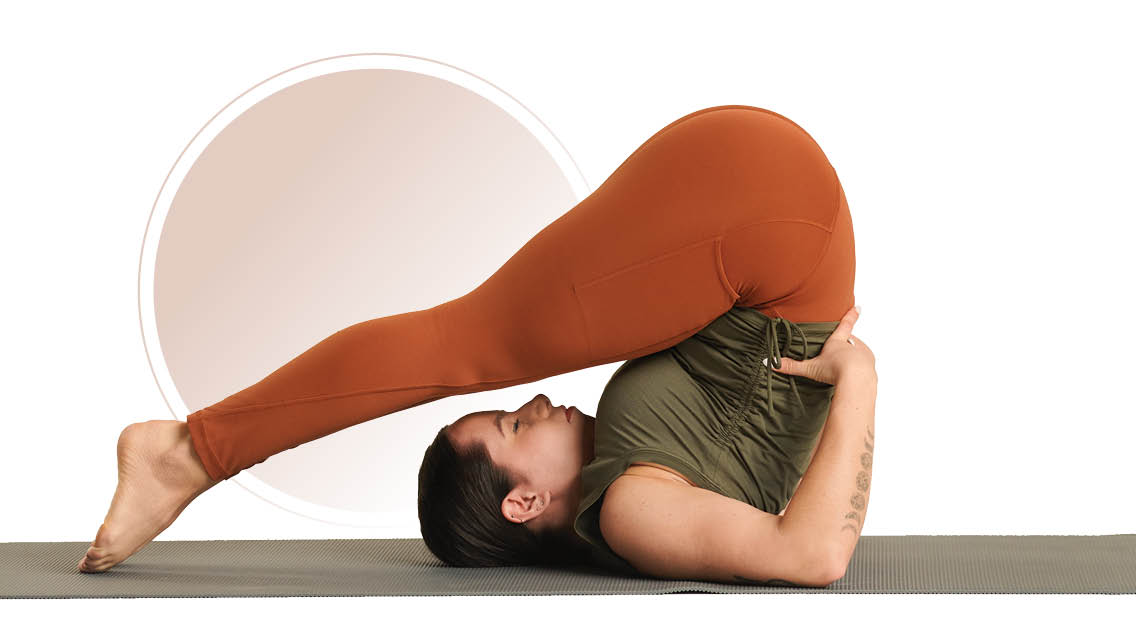
Hold for about 20 breaths.
Full Instructions
- Lie back with your legs extended and arms at your sides, palms down. (For extra shoulder and neck support, stack one or more folded blankets on your mat.)
- Bring your knees to your chest, then straighten your legs toward the ceiling.
- With control, use your core strength to roll your hips up and off the floor until they are stacked over your shoulders. Place your hands on your lower back for support, as needed.
- With your core engaged and feet flexed, slowly lower your legs until your toes come to rest on the ground over your head. (If fully lowering your feet isn’t an option for you, you can keep your feet raised and your hips angled slightly away from, rather than stacked directly over, the shoulders.)
- You can keep your hands on your lower back or place your arms on the floor with hands clasped or palms down.
- Stay active in this posture, pressing your upper arms and shoulders into the floor. Maintain a steady gaze, looking straight ahead or softly down, and avoid turning your head or moving your neck.
- Hold for five to seven breaths. (Over time, work up to holding for two to three minutes.)
- Come out of this posture by slowly rolling down, one vertebra at a time.
- Remain lying on your back for a few moments (about 20 breaths) with your legs extended and arms slightly out at your sides with palms up.
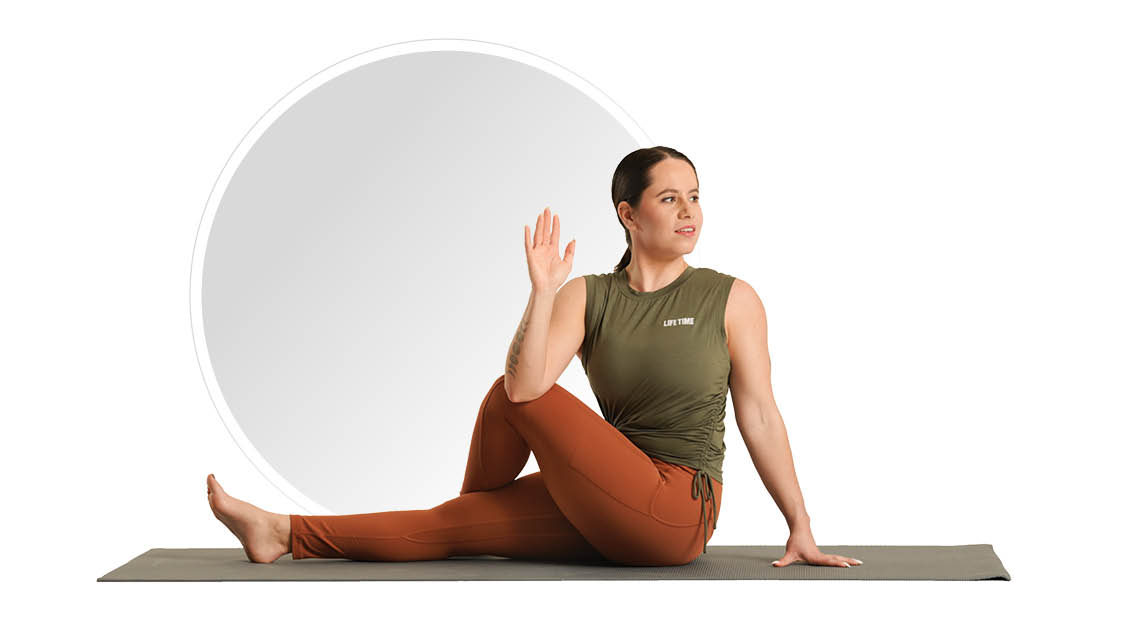



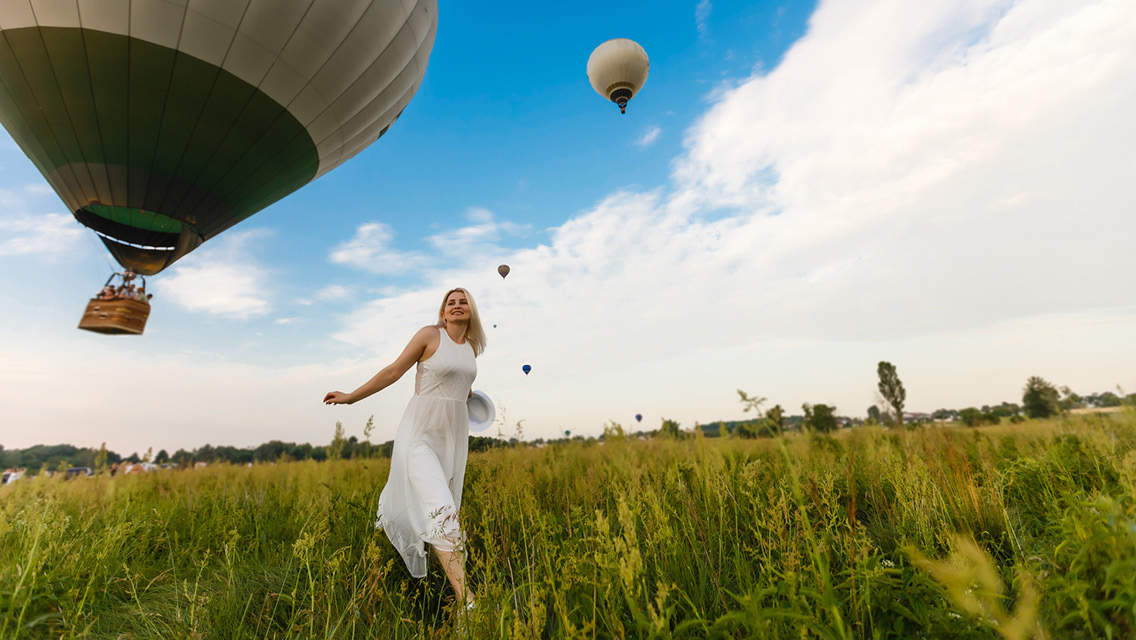
This Post Has 0 Comments